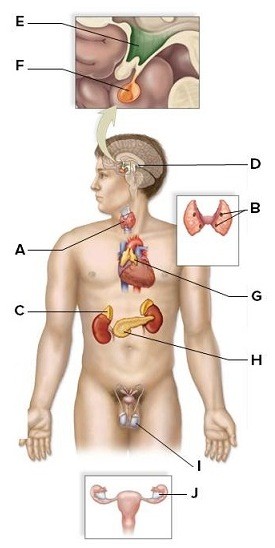Identify and briefly describe the functions of the labeled glands of the human endocrine system. 
What will be an ideal response?
A. thyroid: regulates metabolic rate, growth and development and lowers blood calcium levels.
B. parathyroid: raises blood calcium
C. adrenal glands: The adrenal cortex raises blood glucose levels, stimulates breakdown of proteins, regulates blood volume and pressure, produces male and female sex hormones, and mediates a long-term stress response. The adrenal medulla mediates a short-term stress response.
D. pineal gland: produces melatonin which is involved in the sleep-wake cycle and sexual development
E. hypothalamus: releases and inhibits hormones; regulates the anterior pituitary
F. pituitary gland: produces a variety of hormones such as ADH, oxytocin, TSH, ACTH, FSH, LH, PL, and GH
G. thymus: production and maturation of T lymphocytes
H. pancreas: produces insulin which regulates blood sugar and the formation of glycogen, and glucagon which raises blood sugar level and promotes glycogen breakdown
I. testis: produces the androgen testosterone which produces male sex characteristics
J. ovaries: produce estrogen and progesterone which produce female sex characteristics
You might also like to view...
Which of the following is a correct matching of the researcher with their discovery?
A. Pauling provided information on primary structure in biological molecules. B. Franklin suggested that DNA was a helix with more than one strand and that there were about 10 bases per turn of the DNA C. Watson and Crick collected a large amount of X-ray data on the structure of DNA. D. Chargaff demonstrated that the adenine and cytosine bases and the uracil and guanine bases interacted in some manner.
The type of element is determined by the ________
a. number of electrons b. atomic number c. mass number d. number of neutrons
In order to view a specimen with a total magnification of 400×, a ________ objective must be used if the ocular is 10×.
Fill in the blank(s) with the appropriate word(s).
HIV cannot be transmitted sexually
a. true b. false